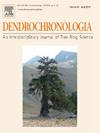Factors affecting dating quality of scarred Picea abies roots: Implications for dendrogeomorphic reconstructions
IF 2.7
3区 农林科学
Q1 FORESTRY
引用次数: 0
Abstract
Exposed and scarred tree roots are valuable environmental archives of geomorphic activity, often used in dendrogeomorphic reconstructions of gully and sheet erosion, debris flood activity, or landslide development. However, their reliability for dating is generally lower compared to tree-ring records in stems. This study aims to evaluate growth anomalies, particularly wedging and missing rings, in Norway spruce roots (Picea abies (L.) Karst.) affected by hydrogeomorphic activity. The objective was to determine whether specific root parameters, such as age, size, shape, or external disturbances, influence the abundance of wedging and potentially missing rings, thereby compromising dating quality. Two datasets of root cross-sections were analysed: (a) 53 cross-sections from eleven roots for multiscale dendrochronological cross-dating and analysis of missing and wedging rings, and (b) 276 cross-sections from 276 individual trees to examine the relationships between wedging ring frequency and root parameters. The results indicate that an increased abundance of wedging and missing rings is mainly associated with decreased annual root area increments and multiple scarring, and is less certainly detectable from increased irregularity in root shape changing from circular to elliptical. Additional analyses also revealed a significantly higher frequency of wedging rings before the first scarring compared to ring sequences after the first scar. To avoid dating errors caused by growth anomalies, future sampling strategies should prioritize thicker roots, which are more likely to have greater root area increments, over smaller roots with a higher probability of extremely narrow rings. Regardless of root age, size, or shape, cutting multiple cross-sections from single roots is strongly recommended to minimize the risk of missing rings.
影响疤痕云杉根测年质量的因素:对树木地貌重建的启示
暴露的和伤痕累累的树根是有价值的地貌活动环境档案,经常用于沟壑和片状侵蚀、泥石流活动或滑坡发展的树木地貌重建。然而,与树干上的年轮记录相比,它们的测年可靠性通常较低。本研究旨在评估挪威云杉根(Picea abies (L.))的生长异常,特别是楔状和缺失环。喀斯特)受水文地貌活动影响。目的是确定特定的根参数,如年龄、大小、形状或外部干扰,是否会影响楔入和潜在缺失环的数量,从而影响测年质量。分析了两组根横截面数据:(a)来自11根的53个横截面,用于多尺度树木年代学交叉测年和分析缺失环和楔环;(b)来自276棵单株的276个横截面,用于研究楔环频率与根参数之间的关系。结果表明,楔环和缺失环的丰度增加主要与根面积增量减少和多发疤痕有关,而根形状从圆形变为椭圆形的不规则性增加则不太确定。其他分析还显示,与第一次瘢痕形成后的环序列相比,第一次瘢痕形成前楔环的频率明显更高。为了避免生长异常造成的测年误差,未来的采样策略应该优先考虑较粗的根,因为它们更有可能具有较大的根面积增量,而不是较小的根,它们更有可能具有极窄的环。无论根的年龄、大小或形状如何,强烈建议从单个根上切割多个横截面,以尽量减少环缺失的风险。
本文章由计算机程序翻译,如有差异,请以英文原文为准。
求助全文
约1分钟内获得全文
求助全文
来源期刊

Dendrochronologia
FORESTRY-GEOGRAPHY, PHYSICAL
CiteScore
5.50
自引率
13.30%
发文量
82
审稿时长
22.8 weeks
期刊介绍:
Dendrochronologia is a peer-reviewed international scholarly journal that presents high-quality research related to growth rings of woody plants, i.e., trees and shrubs, and the application of tree-ring studies.
The areas covered by the journal include, but are not limited to:
Archaeology
Botany
Climatology
Ecology
Forestry
Geology
Hydrology
Original research articles, reviews, communications, technical notes and personal notes are considered for publication.
 求助内容:
求助内容: 应助结果提醒方式:
应助结果提醒方式:


